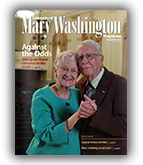 President Richard V. Hurley, chair of the Virginia Council of Presidents, has addressed the topic of STEM in combination with the liberal arts in a variety of settings recently. He wrote about it for the U.S. Chamber of Commerce Foundation’s Business Horizon Quarterly and in an op-ed published in the Richmond Times-Dispatch. What follows was published online in the Huffington Post.
President Richard V. Hurley, chair of the Virginia Council of Presidents, has addressed the topic of STEM in combination with the liberal arts in a variety of settings recently. He wrote about it for the U.S. Chamber of Commerce Foundation’s Business Horizon Quarterly and in an op-ed published in the Richmond Times-Dispatch. What follows was published online in the Huffington Post.
Parents sending their children off to college these days have a right to worry: Unemployment rates are intractably high, college costs are skyrocketing, and students are graduating with unprecedented debt. As the president of a public liberal arts institution, I am especially sensitive to the “return-on-investment” question. And so it is no surprise when high school students and their parents ask our admissions conselors, “Do you offer STEM?”
Without question, STEM is the new buzzword for those anxious about post-graduation employment. STEM is an acronym for science, technology, engineering, and mathematics – all disciplines in which America must excel if it is to retain its industrial and economic strength.
The STEM job sector is growing at twice the rate of non-STEM occupations, according to the U.S. Department of Commerce, but we should note some caveats. First, let’s remember that STEM workers, as identified by the Commerce Department, constitute only 5.5 percent of the workforce. Second, while STEM workers overall may earn 26 percent more than their counterparts, the greatest differential is seen in the lowest-level jobs; the higher the terminal degree, the smaller the earnings difference.
Moreover, it is not a given that the only path to STEM job success is the STEM degree: About one-third of college-educated workers in STEM professions do not hold degrees in STEM. Two-thirds of people holding STEM undergraduate degrees work in non-STEM jobs. One-fifth of math majors, for instance, end up working in education. Nearly 40 percent of STEM managers hold non-STEM degrees.
So to those high school students and parents who anxiously ask, “Do you offer STEM?” I have a couple of things to say: First, remember that we are a college of the liberal arts and sciences. Far too often in casual writing and conversation the “sciences” part is left off of that phrase. Yes, the University of Mary Washington teaches STEM. We offer degrees in math and science, including biology, chemistry, computer science, geographic information systems, environmental science, geology, physics, and the social sciences as well as business and education (teaching). We are pre-law, and we are pre-med.
But better yet, I tell them, “We offer STEM-plus.”
Our STEM education is built on a broad foundation that exposes students to arts, humanities, and social sciences. Our pure and applied science and math disciplines are all built upon our core liberal arts foundation. That’s the plus part.
We all know that the liberal arts and sciences prepare us to be better citizens, to help us understand ourselves and others. But they also prepare us for business and careers. And if our graduates pursue careers in science or technology, they will possess the ability – and I am quoting from our academic catalog here – to “understand, evaluate, articulate, and advance their ideas and the ideas of others.”
The CEOs of Dell, JPMorgan Chase, Walt Disney, IBM, and FedEx all had liberal arts educations. English was the background for both Gen. Martin Dempsey, chairman of the Joint Chiefs of Staff, and Harold Varmus, director of the National Cancer Institute.
New York Times columnist Thomas Friedman, author of The World Is Flat, recently updated his acclaimed book with a whole section on the importance of liberal arts. “It’s not that I don’t think math and science are important,” he said. “They still are. But more than ever our secret sauce comes from our ability to integrate art, science, music, and literature with the hard sciences. That’s what produces an iPod revolution or a Google.”
Friedman could have quoted the late Steve Jobs when he rolled out the iPad2: “It is in Apple’s DNA that technology alone is not enough. It’s technology married with liberal arts, married with humanities, that yields the results that make our hearts sing.”
So who brings together the scientists, the engineers, the designers, and humanists? I think you know by now what I believe. Not every one of our graduates will go on to be a Steve Jobs. But I hope they will be broad thinkers, big thinkers, creative and fearless thinkers.
And that thought makes my heart sing.

[…] column by UMW President Richard V. Hurley in The Huffington Post that I read in University of Mary Washington Magazine, delivered […]